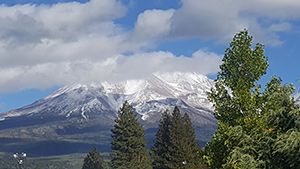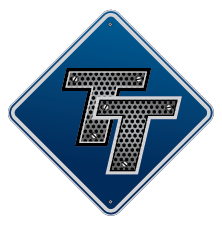Optimal 5th Wheel Position/steer Weight?
Topic 17324 | Page 1

One notch closer to the cab wall should be just fine. In this case it will not put anymore than 11,700 on your steer tires. In order to find the optimal setting, you really should have full fuel tanks, and access to a scale to play around with this.
Curious though why you needed to get on the catwalk to check your reefer??? Unless performing mechanical work, all of the controls you need to check are facing the driver side and are easily visible from the ground.
As a side note, all of the Cascadias I slip-seat with are set with the fifth wheel in the first hole, closest to the cab wall. Full tanks and a 45k balanced load, 11,500-11,700 is the typical weight on the steers. Just to be clear, moving the fifth wheel does, plus or minus change the weight on the drives. So in the case you described the weight added to the steers will come off the drives.
Reefer:
A refrigerated trailer.
On the catwalk cause of being vertically challenged. Lol I do this too cause I'm short. ;)
On my 2015 Cascadia, I have mine set in the 4th notch back from the front. Never over 11900 on the steers, even loaded to the max and full of fuel. Never had to move it yet.

I drove a 2015 Cascadia for a while, and a 2016 briefly. They had significantly different weight distributions on steers.
I occasionally ran very tight on steer weight in the 2015 Cascadia, in the third notch away from the cab.
The heaviest load I ever hauled, 79980 with @ half a tank of fuel, was in the 2016 Cascadia. I ended up having to balance it in the first notch closest to the cab. But even that wasn't enough. The prior driver had left a full set of chains in the truck. My drives were heavy, and I still had over 200 lbs of weight I could put on the steers, so I moved the full set of chains from the sidebox to the footwell of the passenger side seat in the cab.
My current truck, a 2016 Kenworth, is currently set in the 4th notch. I have had a couple loads where the steers got up to 11700, and I've not yet hauled a gross load over @76000 in the truck, so I'm going to leave it in the 4th notch unless I need to move it.

Gtown, I use the catwalk to access the engine of the reefer to check the oil, and look at the belts, also, my company uses zonar scan tags for entering Pre trip on the computer, often, the front trailer scan tag is behind the reefer door.
Reefer:
A refrigerated trailer.

Gtown, I use the catwalk to access the engine of the reefer to check the oil, and look at the belts, also, my company uses zonar scan tags for entering Pre trip on the computer, often, the front trailer scan tag is behind the reefer door.
Okay...figured it was something like that. Walmart doesn't require us to do that.
Reefer:
A refrigerated trailer.
You're going to want to get as close to 12,000 as you can with a heavy load and at least 1/2 tank of fuel. If you don't use the weight allowance you're given on the steers you won't be able to haul quite as much legally. Not only that, but in the winter you want to make sure you have plenty of weight on those steers to keep a good grip on slick roads.
Also, look at the Rand McNally and see what the steer axle weight allowances are in the states you normally run. A lot of states allow 20,000 but you wouldn't be able to go that high anyhow because you won't have tires rated to handle that much weight. But it shows you don't have to worry about that 12,000 in a lot of states.
There's no advantage to moving the weight off that steer axle, especially going into winter. Think about how much weight you're removing - potentially 400 pounds from each steer tire when you're only at 11,200. I regularly carry 50 pound bags of grain for my animals. To think you could have the additional traction of eight more of those on each steer tire? Yeah, I would definitely want that weight on those tires.
HOS:
Hours Of Service
HOS refers to the logbook hours of service regulations.Sambo, this is off-topic, but I don't know how to contact you otherwise... one of your photos, two highway lanes, one in each direction, split-level, river off to the side... is that outside of Glenwood Springs, CO? Looks really familiar...
In both Cascadias I've had (2016 and 2014) I've had it in the first hole. I usually don't go over 12,000. But like Brett said, most states allow up to 20,000 anyways so your max legal weight is going to be based on what your steers are rated at.
New Reply:
New! Check out our help videos for a better understanding of our forum features

















Preview:








 TT On Facebook
TT On Facebook
So, when I got this truck [2014 pro star], the 5th wheel was slid all the way to the front, with the shorter wheel base compared to the volvo, it made.it a tight space to get up on the catwalk to check the reefer unit.
I slid the 5th wheel back 3 slots, and now there is room. What I am finding though is that, every time I scale, my steers are at 11200. I've heard drivers say they like to run their steers right at 1200, possibly just a little above.
Now, running close or just a little above legal weight....will dot give you a small allowance? If I moved my 5th wheel up 1 slot, that should put me at 11700, correct?
Since the steers receive a small percentage of the load weight, and a larger percentage of fuel weight, would this be optimal?
When I scaled this last load, steers were 11200 with just under half a tank of fuel.
I'm wondering if I move it up one notch, will I remain legal on a full tank, and will it improve the handling of the truck?
Seems like if I did this, I should never have to worry about steer weights or having to slide the 5th wheel ever again, since I'd always be near max weight on the steer axle.
Thoughts?
DOT:
Department Of Transportation
A department of the federal executive branch responsible for the national highways and for railroad and airline safety. It also manages Amtrak, the national railroad system, and the Coast Guard.
State and Federal DOT Officers are responsible for commercial vehicle enforcement. "The truck police" you could call them.
Reefer:
A refrigerated trailer.